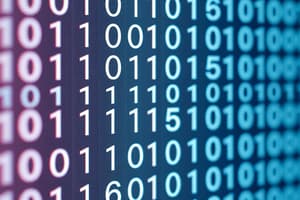Podcast
Questions and Answers
What is the range of numbers that can be represented in n-bit unsigned binary number representation?
What is the range of numbers that can be represented in n-bit unsigned binary number representation?
What is the function of the MSB in signed binary number representation?
What is the function of the MSB in signed binary number representation?
How are negative numbers represented in 1's complement form?
How are negative numbers represented in 1's complement form?
What is the number of digits used to represent binary numbers?
What is the number of digits used to represent binary numbers?
Signup and view all the answers
What is the representation of +9 in eight-bit notation?
What is the representation of +9 in eight-bit notation?
Signup and view all the answers
What is the direction of reading binary numbers?
What is the direction of reading binary numbers?
Signup and view all the answers
What is the purpose of binary numbers in digital systems?
What is the purpose of binary numbers in digital systems?
Signup and view all the answers
What is the process of obtaining a two's complement number?
What is the process of obtaining a two's complement number?
Signup and view all the answers
What does the MSB represent in the two's complement representation?
What does the MSB represent in the two's complement representation?
Signup and view all the answers
How are negative magnitudes represented in the two's complement representation?
How are negative magnitudes represented in the two's complement representation?
Signup and view all the answers
What is the two's complement of the binary number '1100'?
What is the two's complement of the binary number '1100'?
Signup and view all the answers
What is the trick to find the two's complement of a binary number?
What is the trick to find the two's complement of a binary number?
Signup and view all the answers
Study Notes
1s and 2s Complement
Binary Numbers
Binary numbers are a way of representing numbers using just two digits: 0 and 1. They are used in digital systems, such as computers, to store and transmit information. Binary numbers are read from left to right, with the leftmost digit (the most significant bit, or MSB) representing the highest power of 2.
Unsigned Binary Numbers
Unsigned binary numbers can be represented using only positive numbers. For n-bit unsigned binary numbers, all n bits are used to represent the magnitude of the number. The range of numbers that can be represented in unsigned binary number representation is from 0 to 2^n - 1.
Signed Binary Numbers
Signed binary numbers can represent both positive and negative numbers. In signed binary number representation, the MSB is used as a sign bit. For positive numbers, the sign bit is 0, and for negative numbers, the sign bit is 1. There are three different ways to represent signed binary numbers: sign-magnitude form, 1's complement form, and 2's complement form.
1s Complement
1's complement is a way of representing signed binary numbers. The one's complement of a binary number is obtained by toggling all bits in it, i.e., transforming the 0 bit to 1 and the 1 bit to 0. In the one's complement representation, the positive numbers remain unchanged, and the negative numbers are obtained by taking the one's complement of the positive counterparts. For example, +9 is represented as 00001001 in eight-bit notation, and -9 is represented as 11110110, which is the one's complement of 00001001.
2s Complement
2's complement is another way of representing signed binary numbers. It is the process of converting a signed binary number to a two's complement number. The two's complement of a binary number is obtained by 1) taking the one's complement (inverting all bits), and then 2) adding 1 to the result. In the two's complement representation, the MSB represents the sign with a '0' used for the plus sign and a '1' used for the minus sign. The remaining bits are used for representing the magnitude. Positive magnitudes are represented in the same way as in the case of sign-bit or one's complement representation. Negative magnitudes are represented by the two's complement of their positive counterparts.
For example, the two's complement of "0111" is "1001", and the two's complement of "1100" is "0100". A simple trick to find the two's complement of a binary number is to start from the least significant bit (LSB) and traverse left until you find a 1. Once you find a 1, let it stay the same and then flip all the bits left into the 1. For example, to find the two's complement of "100100", you would first let the bit stay the same until you find 1. In this case, you would find 1 at step 3, so the answer would be "011100".
Studying That Suits You
Use AI to generate personalized quizzes and flashcards to suit your learning preferences.
Description
Learn about binary numbers, including unsigned and signed binary numbers, and how to represent signed binary numbers using 1s complement and 2s complement forms. Practice converting binary numbers to their 1s and 2s complement representations.





